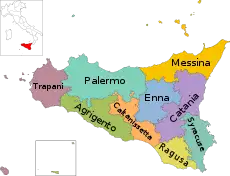Sicilians
Sicilians or the Sicilian people (Siciliani in Italian, Neapolitan and Sicilian, or also Siculi in Italian[2]) are a Romance[3] and Southern Italian ethnic group who are indigenous to the Italian island of Sicily, the largest island in the Mediterranean Sea, as well as the largest and most populous of the autonomous regions of Italy.
| Regions with significant populations | |
|---|---|
(inhabitants of Sicily) | 4,969,147[1] |
| Languages | |
| Italian • Sicilian • Gallo-Sicilian | |
| Religion | |
| Christianity: Predominantly Roman Catholic (Latin and Norman Rites) | |
Origin and influences
The Sicilian people are indigenous to the island of Sicily, which was first populated beginning in the Paleolithic and Neolithic periods.
Prehistory
The aboriginal inhabitants of Sicily, long absorbed into the population, were tribes known to the ancient Greek writers as the Elymians, the Sicanians, and the Sicels, the latter being an Indo-European-speaking people of possible Italic affiliation, who migrated from the Italian mainland (likely from the Amalfi Coast or Calabria via the Strait of Messina) during the second millennium BC, after whom the island was named. The Elymian tribes have been speculated to be a pre-Indo-European people who migrated to Sicily from either Central Anatolia, Southern-Coastal Anatolia, Liguria (Cinque Terre Coast), or one of the Aegean Islands, or perhaps were a collection of native migratory maritime-based tribes from all previously mentioned regions. When the Elymians migrated to Sicily is unknown, however scholars of antiquity considered them to be the second oldest inhabitants, while the Sicanians, thought to be the oldest inhabitants of Sicily by scholars of antiquity, were speculated to also be a pre-Indo-European tribe, who migrated via boat from the Xúquer river basin in Castellón, Cuenca, Valencia and Alicante. The name 'Sicanus' has been asserted to have a possible link to the modern river known in Valencian as the Xúquer and in Castilian as the Júcar.[4][5][6][7][8][9][10][11][12][13][14]
All three tribes lived both a sedentary pastoral and orchard farming lifestyle, and a semi-nomadic fishing, transhumance and mixed farming lifestyle. Prior to the Neolithic Revolution, Paleolithic Sicilians would have lived a hunter-gatherer lifestyle, just like most human cultures before the Neolithic. The river Salsu was the territorial boundary between the Sicels and Sicanians. They wore basic clothing made of wool, plant fibre, papyrus, esparto grass, animal skins, palm leaves, leather and fur, and created everyday tools, as well as weapons, using metal forging, woodworking and pottery. They typically lived in a nuclear family unit, with some extended family members as well, usually within a drystone hut, a neolithic long house or a simple hut made of mud, stones, wood, palm leaves or grass. Their main methods of transportation were horseback, donkeys and chariots. Evidence of pet wildcats, cirneco dogs and children's toys have been discovered in archaeological digs, especially in cemetery tombs. Their diet was a typical Mediterranean diet, including unique food varieties such as Gaglioppo, Acitana and Diamante citron, while in modern times the Calabrian Salami, which is also produced in Sicily, and sometimes used to make spicy 'Nduja spreadable paste/sauce, is a popular type of salami sold in Brazil and the Anglosphere. All 3 tribes also specialised in building megalithic single-chambered dolmen tombs,[15] a tradition which dates back to the Neolithic. "An important archaeological site, located in Southeast Sicily, is the Necropolis of Pantalica, a collection of cemeteries with rock-cut chamber tombs. Dating from the 13th to the 7th centuries BC., recent estimates suggests a figure of just under 4,000 tombs. They extend around the flanks of a large promontory located at the junction of the Anapo river with its tributary, the Calcinara, about 23 km (14 mi) northwest of Syracuse. Together with the city of Syracuse, Pantalica was listed as a UNESCO World Heritage Site in 2005. The site was mainly excavated between 1895 and 1910 by the Italian archeologist, Paolo Orsi, although most of the tombs had already been looted long before his time. Items found within the tombs of Pantalica, some now on display at the Archaeology Museum in Syracuse, were the characteristic red-burnished pottery vessels, and metal objects, including weaponry (small knives and daggers) and clothing, such as bronze fibulae (brooches) and rings, which were placed with the deceased in the tombs. Most of the tombs contained between one to seven individuals of all ages and both sexes. Many tombs were evidently re-opened periodically for more burials. The average human life span at this time was probably around 30 years of age, although the size of the prehistoric population is hard to estimate from the available data, but might have been around 1000 people."[16][17][18][19][20][21][22]
Nuragic ceramic remains, (from Sardinia), carbon dated to the 13th century BC, have been found in Lipari.[23] The prehistoric Thapsos culture, associated with the Sicani, shows noticeable influences from Mycenaean Greece.[24] The type of burial found in the necropolis of the Thapsos culture, is characterized by large rock-cut chamber tombs, and often of tholos-type that some scholars believe to be of Mycenaean derivation, while others believe it to be the traditional shape of the hut. The housing are made up of mostly circular huts bounded by stone walls, mainly in small numbers. Some huts have rectangular shape, particularly the roof. The economy was based on farming, herding, hunting and fishing. There are numerous evidences of trading networks, in particular of bronze vessels and weapons of Mycenaean and Nuragic (Sardinian) production. There were close trading relationships/networks established with the Milazzo Culture of the Aeolian Islands,[25] and with the Apennine culture of mainland southern Italy. In Sicily's earlier prehistory, there is also evidence of trade with the Capsian and Iberomaurusian mesolithic cultures from Tunisia, with some lithic stone sites attested in certain parts of the island.[26][27][28]
Another archaeological site, originally identified by Paolo Orsi on the basis of a particular ceramic style, is the Castelluccio culture which dates back to the Ancient Bronze Age (2000 B.C. approximately), and is seen as sort of a "prehistoric proto-civilization", located between Noto and Siracusa.[29] The discovery of a prehistoric village in Castelluccio di Noto, next to the remains of prehistoric circular huts, led to finds of Ceramic glass decorated with brown lines on a yellow-reddish background, and tri-color with the use of white. The weapons used in the days of Castelluccio culture were green stone and basalt axes and, in the most recent settlements, bronze axes, and frequently carved bones, considered idols similar to those of Malta, and of Troy II and III. Burials were made in rounded tombs carved into the rock, with doors with relief carving of spiral symbols and motifs that evoke the sexual act. The Castelluccio culture is dated to a period between 2200 BC and 1800 BC,[30] although some believe it to be contemporary to the Middle-Late Helladic period (1800/1400 BC)."[31] "Sites related to the Castelluccio culture were present in the villages of south-east Sicily, including Monte Casale, Cava/Quarry d'Ispica, Pachino, Niscemi, Cava/Quarry Lazzaro, near Noto, of Rosolini, in the rocky Byzantine district of coastal Santa Febronia in Palagonia, in Cuddaru d' Crastu (Tornabé-Mercato d'Arrigo) near Pietraperzia, where there are remains of a fortress partly carved in stone, and - with different ceramic forms - also near Agrigento in Monte Grande. The discovery of a cup of 'Etna type' in the area of Comiso, among local ceramic objects led to the discovery of commercial trades with the Castelluccio sites of Paternò, Adrano and Biancavilla, whose graves differ in making due to the hard basaltic terrain and also for the utilization of the lava caves as chamber tombs. In the area around Ragusa, there have been found evidences of mining among the ancient residents of Castelluccio; tunnels excavated by the use of basalt bats allowed the extraction and production of highly sought flints. Some dolmens, dated back to this same period, with sole funeral function, are found in different parts of Sicily and attributable to a people not belonging to the Castelluccio Culture."[32]
The Sicelian' polytheistic worship of the ancient and native chthonic, animistic-cult deities associated with geysers known as the Palici, and/as well as the worship of the volcano-fire god by the name of Adranos, were also worshiped throughout Sicily by the Elymians and Sicanians. Their (Palici) centre of worship was originally based on three small lakes that emitted sulphurous vapors in the Palagonian plains, and as a result these twin brothers were associated with geysers and the underworld. There was also a shrine to the Palici in Palacia, where people could subject themselves or others to tests of reliability through divine judgement; passing meant that an oath could be trusted. The mythological lineage of the Palici is uncertain. According to Macrobius, the nymph Thalia gave birth to the divine twins while living underneath the Earth.[33] They were most likely either the sons of the native fire god Adranos, or, as Polish historian "Krzysztof Tomasz Witczak" suggests, the Palici may derive from the old Proto-Indo-European mytheme of the divine twins.[34] Mount Etna is named after the mythological Sicilian nymph called Aetna, who might have been the possible mother to the Palici twins.[35] Mount Etna was also believed to have been the region where Zeus buried the Serpentine giant Typhon, and the humanoid giant Enceladus in classical mythology. The Cyclopes, giant one eyed humanoid creatures in classical Greco-Roman mythology, known as the maker of Zeus' thunderbolts, were traditionally associated with Sicily and the Aeolian Islands. The Cyclopes were said to have been assistants to the Greek blacksmith God Hephaestus, at his forge in Sicily, underneath Mount Etna, or perhaps the nearby Aeolian Islands. The Aeolian Islands, off the coast of Northwestern Sicily, were themselves named after the mythological king and "keeper of the heavy winds" known as Aeolus.[36] In his Hymn to Artemis, Cyrene poet Callimachus states that the Cyclopes on the Aeolian island of Lipari, working "at the anvils of Hephaestus", make the bows and arrows used by Apollo and Artemis.[37] The Hesiodic Latin poet Ovid names three Cyclopes "Brontes, Steropes and Acmonides" working as forgers inside Sicilian caves.[38][39] Besides Demeter (the Greek goddess of agriculture and law & order), and Persephone (the Greek personified goddess of vegetation),[40] The Phoenician bull god Moloch (a significant deity also mentioned in the Hebrew Bible), the Phoenician moon goddess of fertility and prosperity Astarte (with her Roman equivalent being Venus), the Punic goddess Tanit,[41] and the weather & war god Baal (which later evolved into the Carthaginian god Baal Hammon), also had centres of cultic-worship throughout Sicily. The river Anapo was viewed as the personification of the water god Anapos in Sicilian mythology.[42][43][44][45] The Elymians inhabited the western parts of Sicily, while the Sicanians inhabited the central parts, and the Sicels inhabited the eastern parts.[46][47][48][49][50][51][52][53][54][55][56]
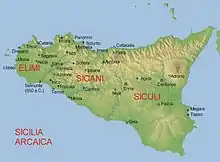
Ancient history
From the 11th century BC, Phoenicians began to settle in western Sicily, having already started colonies on the nearby parts of North Africa and Malta. Sicily was later colonized and heavily settled by Greeks, beginning in the 8th century BC. Initially, this was restricted to the eastern and southern parts of the island. As the Greek and Phoenician communities grew more populous and more powerful, the Sicels and Sicanians were pushed further into the centre of the island. The independent Phoenician colonial settlements were eventually absorbed by Carthage during the 6th Century BC. By the 3rd century BC, Syracuse was the most populous Greek city state in the world. Sicilian politics was intertwined with politics in Greece itself, leading Athens, for example, to mount the disastrous Sicilian Expedition against Syracuse in 415-413 BC during the Peloponnesian War, which ended up severely affecting a defeated Athens, both politically and economically, in the following years to come. Another battle which Syracuse took part in, this time under the Tyrant Hiero I of Syracuse, was the Battle of Cumae, where the combined navies of Syracuse and Cumae defeated an Etruscan force, resulting in significant territorial loses for the Etruscans.[57][58] The constant warfare between Ancient Carthage and the Greek city-states eventually opened the door to an emerging third power. In the 3rd century BC, the Messanan Crisis, caused by Mamertine mercenaries from Campania, when the city-states of Messina (Carthaginian-owned) and Syracuse (Dorian-owned) were being constantly raided and pillaged by Mamertines, during the period (282-240 BC) when Central, Western and Northeast Sicily were put under Carthaginian rule, motivated the intervention of the Roman Republic into Sicilian affairs, and led to the First Punic War between Rome and Carthage. By the end of the war in 242 BC, and with the death of Hiero II, all of Sicily except Syracuse was in Roman hands, becoming Rome's first province outside of the Italian peninsula. For the next 600 years, Sicily would be a province of the Roman Republic and later Empire. Prior to Roman rule, there were three native Elymian towns by the names of Segesta, Eryx and Entella, as well as several Siculian towns called Agyrion, Kale Akte (founded by the Sicel leader Ducetius), Enna and Pantalica, and one Sicanian town known as Thapsos. (Greek: Θάψος)
Sometime after Carthage conquered most of Sicily except for the Southeast which was still controlled by Syracuse, Pyrrhus of Epirus, the Molossian king of Epirus, was installed as King/Tyrant of Sicily from 278 to 275 BC, even capturing the native Elymian mountain-city of Eryx, which was previously under Carthaginian fortification & protection before he captured it. Pyrrhus even attempted to capture Lilybaeum (Siege of Lilybaeum) from the Punics, which didn't succeed. A couple years later (275 BC), Envoys from Southern Italy had notified him that of all the Greek cities in Italy, only Tarentum hadn't fallen to the Romans. Upon hearing this, coinciding with the fact that the Sicilian city-states had started becoming hostile towards him, due to him trying to force Sicily into becoming a martial state, Pyrrhus made his decision to depart from the island and dethrone himself, leaving Syracuse and Carthage in charge of the island again. As his ship left the island, he turned and, foreshadowing the Punic Wars, said to his companions: "What a wrestling ground we are leaving, my friends, for the Carthaginians and the Romans." While his army was being transported by ship to mainland Italy, Pyrrhus' navy was destroyed by the Carthaginians at the Battle of the Strait of Messina, with 98 warships sunk or disabled out of 110. After Pyrrhus of Epirus landed on Mainland Italy, his Roman opponents had mastered up a large army under Roman consul Manius Curius Dentatus, while he was still Tyrant of Sicily. After Pyrrhus was defeated at the Battle of Beneventum (275 BC) by the Romans, he decided to end his campaigns against Southern Italy, and return to Epirus, resulting in the loss of all his territorial gains in Italy. The city of Tarentum however still remained under Epirote control.
The ancient historian Diodorus Siculus who wrote and recorded the monumental works of manuscripts about universal world/human history called Bibliotheca historica, and the ancient Doric-Greek revolutionary scientist, inventor and mathematician Archimedes who anticipated modern calculus, and analysis by applying methods of infinitesimals and exhaustion to rigorously derive and prove the range of geometric theorems, and invented the innovative Archimedean screw, compound pulleys, and defensive war machines to protect his native town of Syracuse from invasions, were both born, grew up in, lived and died in Sicily.
Middle ages
As the Roman Empire was falling apart, a Germanic tribe known as the Vandals along with an Iranian tribe known as the Alans took over Sicily for a relatively brief period beginning in 468 AD under the rule of their king Geiseric, forming the Kingdom of the Vandals. The Vandals and Alans gained a monopoly on the Mediterranean grain trade during their monarchical reign, with all grain taxes being monitored by them. Due to the Western Roman Empire being too preoccupied with war in Gaul, when the Vandals & Alans started invading Sicily in 440, the Romans could not respond. Eastern Roman Emperor Theodosius II sent a failed expeditionary force to deal with them in 441, which ended in a Vandal-Alan counter-victory. However, they soon lost these newly acquired possessions, except for one toehold in Lilybaeum, to Odoacer (an Arian Christian Barbarian statesman & general of possible East Germanic & Hunnic descent, and client king under Zeno whose reign over Italy marked the Fall of the Western Roman Empire) in 476 and completely to the Ostrogothic conquest of Sicily by Theodoric the Great which began in 488; although the Goths were Germanic, Theodoric sought to revive Roman culture and government and allowed freedom of religion. In contrast to the prior Carthaginian, Syracusan (Dorian) and Roman Empires which ruled Sicily in the past, Sicily did not serve as a distinct province or administrative region under Germanic control, although it did retain a certain amount of autonomy. The Gothic War took place between the Ostrogoths and the Byzantine Empire (with its capital-city based at Constantinople, modern Istanbul), and during the reign of Justinian I, Sicily was brought back under Greco-Roman rule under the military expeditions of Byzantine generals Flavius Belisarius and Narses, resulting in Byzantine-Greek language and religion being embraced by the majority of the population. It was Syracuse where the Byzantine Emperor Constans II desired to move his capital in 663 AD, a decision which eventually led to his assassination. Sicily remained under autonomous stable Byzantine rule as the Theme/Province of Sicily (Theme (Byzantine district)) for several peaceful centuries, until an invasion by Arab Muslims (Aghlabids from the Banu Tamim Clan) in the 9th century.
Besides Sicily, the Theme or Province of Sicily also included the adjacent region of Calabria in Mainland Italy. The capital city of Byzantine Sicily was Syracuse. The province was looked after by the imperial governor known as a Praetor, and was militarily protected under a general by the title of Dux. Sicily itself was divided into many districts known as a Turma. The Byzantine Exarch of Ravennan Italy named Theophylact, between 702 and 709, originally came from Sicily. After he got promoted into the Exarchate, Theophylact marched from Sicily to Rome for unknown reasons, a decision which angered the local Roman soldiers living there, however the newly elected Pope John VI, was able to calm them down.[59] While Theophylact was still Exarch, Byzantine Emperor Justinian II seized all the leading citizens and officials of Ravenna at a local banquet, and dragged them abroad a ship to Constantinople. He sentenced all but one of the Ravennan captives to death, the exception being Archbishop Felix, who was permanently blinded instead.[60] This was due to a recent rebellion which Ravenna took part in, in 695. Justinian II later sacked Ravenna, weakening the Exarchate in charge of it. Theophylact was not a victim of the catastrophe, but was the first Exarch to experience a weakened Ravenna. Theophylact possibly moved back to Sicily after he retired from the Exarchate in 709. Theophylact might have also been the Strategos of Sicily from 700 to 710. The Strategos of Sicily was also able to exercise some control over the autonomous duchies of Naples, Gaeta and Amalfi, depending on the local political situation or faction at the time.
The Aghlabid invasions were in part caused by the Byzantine-Sicilian military commander Euphemius, who invited the Aghlabids to aid him in his rebellion against the imperial governor of Sicily in 826 AD. A similar situation happened a century prior, when the imperial governor of Sicily (Sergios), had declared a Byzantine official from Constantinople by the name of Basil Onomagoulos (regnal name Tiberius) as rival emperor, when false news reached Sicily that Constantinople had fallen to the Umayyads. When Emperor Leo the Syrian sent an administrative official named Paul to Sicily, the people and army of Syracuse surrendered Basil and his rebels up to him, leading to the beheading of Basil, while the former governor Sergios was able to escape to the parts of Mainland Italy controlled by the Lombards. Another rebellion took place between the years 781–793, when the aristocratic governor of Sicily, Elpidius, was accused of conspiring against Empress Irene in favour of Nikephoros. After Elpidius's forces were militarily defeated by Empress Irene's large fleet dispatched in Sicily, he, along with his lieutenant, the dux of Calabria named Nikephoros, defected to the Abbasid Caliphate, where he was posthumously acknowledged as rival emperor. After losing another military expedition, this time against Asia Minor with the help of the Abbasids, he advised the Abbasid Emir of Mesopotamia, Abd al-Malik ibn Salih, to "throw away his silk and put on his armour", warning him against the aggressive new reign of Nikephoros I. The Muslim conquest was a see-saw affair; the local population resisted fiercely and the Arabs suffered considerable dissension and infighting among themselves during this process. Not until 965 was the island's conquest successfully completed by the Fatimid Caliphate, with Syracuse in particular resisting almost to the end (Siege of Syracuse (877-878)). Jawhar the Sicilian, the Fatimid general of Slavic origins that led the conquest of Egypt, under Caliph Al-Mu'izz li-Din Allah, was born and grew up in Ragusa, Sicily. Jawhar served as viceroy of Egypt until 973, consolidating Fatimid control over North Africa, and laying the foundations for Cairo.[61][62]
The first phase of Muslim rule began with the conquests of the third Aghlabid Emir Ziyadat Allah I of Ifriqiya, and consolidated with the reign of the ninth Emir Ibrahim II of Ifriqiya after the conquest of Taormina. The first attempt to capture Syracuse was under general Asad ibn al-Furat, although it ended in a Byzantine victory. A strong combination of Ifriqiyan, Persian and Andalusian troops helped to capture the Island between 830 and 831. After a revolt was suppressed, the Fatimid Caliph Al-Mansur Billah appointed a member of the Kalbid dynasty, Al-Hasan ibn Ali al-Kalbi, as First Emir of Sicily. The Kalbids ruled Sicily from 948 to 1053. Al-Mu'izz ibn Badis, fourth ruler of the Zirid Sanhaja dynasty in North Africa, attempted to annex the island for the Zirids, but his attempts failed. The new Arab-Berber rulers initiated revolutionary land reforms, which in turn increased productivity and encouraged the growth of smallholdings, a dent to the dominance of the landed estates. The Arabs further improved irrigation systems through Qanats, introducing oranges, lemons, pistachio, and sugarcane to Sicily. Ibn Hawqal, a Baghdadi merchant who visited Sicily in 950, commented that a walled suburb called the Kasr (the palace) was the center of Palermo, with the great Friday mosque on the site of the later Roman Catholic cathedral. The suburb of Al-Khalisa (Kalsa) contained the Sultan's palace, baths, a mosque, government offices, and a private prison. Ibn Hawqual reckoned there were 7,000 individual butchers trading in 150 shops. By 1050, Palermo had a population of 350,000, making it one of the largest cities in Europe, behind Moorish-Spain's capital Córdoba and the Byzantine capital of Constantinople, which had populations over 450–500,000. Palermo's population dropped to 150,000 under Norman rule. By 1330 Palermo's population had declined to 51,000, possibly due to the inhabitants of the region being deported to other regions of Norman Sicily, or to the Norman County of Apulia and Calabria. The Arab traveler Ibn Jubayr from Al-Andalus stated that the buildings built during this period were made of limestone. The Latinized Catholic Sicilians in Western Sicily still continued to revolt until Norman rule, and the Greek-speaking Byzantine Orthodox-Catholic Sicilians in the East (mainly concentrated in the Val Demone region) almost secured their independence several times during their revolts. Christians and Jews were tolerated in Muslim Sicily as dhimmis, and had to pay the Jizya poll tax, and Kharaj land tax, but were exempt from the Zakat alms-giving tax Muslims had to pay. Many Jews immigrated to Sicily during Muslim rule, but left after the Normans arrived.
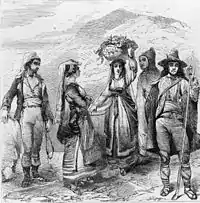
In the 11th century, the mainland southern Italian powers were hiring Norman mercenaries, who were Christian descendants of the Vikings; it was the Normans under Roger I (of the Hauteville dynasty) who conquered Sicily from the Muslims over a period of thirty years until finally controlling the entire island by 1091 as the County of Sicily. In 1130, Roger II founded the Norman Kingdom of Sicily as an independent state with its own Parliament, language, schooling, army and currency, while the Sicilian culture evolved distinct traditions, clothing, linguistic changes, cuisine and customs not found in mainland Italy.[63] A great number of families from northern Italy began settling in Sicily during this time, with some of their descendants forming distinct communities that survive to the present day, such as the Lombards of Sicily. Other migrants arrived from southern Italy, as well as Normandy and parts of southern France.
The Siculo-Norman rule of the Hauteville dynasty continued until 1198, when Frederick II of Sicily, the son of a Siculo-Norman queen and a Swabian-German emperor ascended the throne. In fact, it was during the reign of this Hohenstaufen (Swabian-German) king Frederick II, that the poetic form known as a sonnet was invented by Giacomo da Lentini, the head Poet, Teacher and Notary of the Sicilian School for Poetry. Frederick II was also responsible for the Muslim settlement of Lucera. His descendants governed Sicily until the Papacy invited a French prince to take the throne, which led to a decade-and-a-half of French rule under Charles I of Sicily; he was later deposed in the War of the Sicilian Vespers against French rule, which put the daughter of Manfred of Sicily - Constance II and her husband Peter III of Aragon, a member of the House of Barcelona, on the throne. Their descendants ruled the Kingdom of Sicily until 1401. Following the Compromise of Caspe in 1412 the Sicilian throne passed to the Iberian monarchs from Aragon and Castile.
Modern and Contemporary history
In 1735, the Spanish era ended when Charles V from the House of Bourbon was crowned king. For the better part of the next century-and-a-half, Sicily was in personal union with the other Southern Italian Kingdom of Naples, with the official residence located in Naples, under the Bourbon dynasty. After the Napoleonic Wars, King Ferdinand I, who had just recently been restored back to the throneship of Southern Italy in 1815, made a decision to administratively and politically merged the two separate Kingdoms of Naples & Sicily, which ended up forming the Kingdom of the Two Sicilies in 1816. In 1861, however, Sicily became part of the Kingdom of Italy as a result of the Risorgimento. Prior to the Risorgimento, the Two Sicilies were conquered by the Kingdom of Sardinia during the Expedition of the Thousand (led by general Giuseppe Garibaldi) in 1860, and subsequently brought under the monarchial realm of Sardinia. After the unification of Italy and the Fascist era, a wave of Sicilian nationalism led to the adoption of the Statute of Sicily, under which the island has become an autonomous region. Since 1946, the island enjoys the most advanced special status of all the autonomous regions, which allows the Sicilian residents to keep 100% of the revenue from all the taxes, without giving back any to the central government in Rome.
Demographics
| Year | Pop. | ±% |
|---|---|---|
| 1861 | 2,409,000 | — |
| 1871 | 2,590,000 | +7.5% |
| 1881 | 2,933,000 | +13.2% |
| 1901 | 3,568,000 | +21.7% |
| 1911 | 3,812,000 | +6.8% |
| 1921 | 4,223,000 | +10.8% |
| 1931 | 3,906,000 | −7.5% |
| 1936 | 4,000,000 | +2.4% |
| 1951 | 4,487,000 | +12.2% |
| 1961 | 4,721,000 | +5.2% |
| 1971 | 4,681,000 | −0.8% |
| 1981 | 4,907,000 | +4.8% |
| 1991 | 4,966,000 | +1.2% |
| 2001 | 4,969,000 | +0.1% |
| 2011 | 5,002,904 | +0.7% |
| 2017 | 5,029,615 | +0.5% |
| Source: ISTAT 2017 | ||
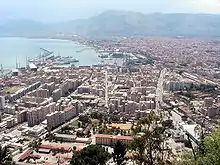
Sicily has experienced the presence of a number of different cultures and ethnicities in its vast history, including the aboriginal peoples of differing ethnolinguistic origins (Sicani, Siculi and Elymians), Phoenicians and Carthaginians, Ancient Greeks (Magna Graecia), Romans and Jews during the ancient and classical periods.
In the early medieval era, Sicily experienced the brief rule of Germanic Vandals and Iranic Alans during the Kingdom of the Vandals and Alans, while under Byzantine, Saracen and Norman rule, there were Byzantine Greeks, Arabs, Berbers, Normans, Swabians and Italians.[64] From the late medieval period into the modern era, Aragonese, Spaniards and French ruled over and left a minor impact on the island, while Albanians settled and formed communities which still exist today known as the Arbereshe.
About five million people live in Sicily, making it the fourth most populated region in Italy. However, in the first century after the Italian unification, Sicily had one of the most negative net migration rates among the regions of Italy because of millions of people moving to the Italian mainland and countries like Germany, Sweden, Belgium, the United States, Canada, Australia, Brazil, Argentina, the United Kingdom, France, New Zealand, Singapore and South Africa.[65] Many Sicilian communities, including those formed by the descendants of the Sicilian migrants, are all over the world. It is estimated that the number of people of Sicilian descent in the world is more than six million.[66] The most famous community is represented by the Sicilian Americans. Like the other parts of Southern Italy, immigration to the island is relatively low compared to other regions of Italy because workers tend to head to Northern Italy instead, in search of better employment and industrial opportunities. The most recent ISTAT figures[67] show around 175,000 immigrants out of the total of almost 5.1 million population (nearly 3.5% of the population); Romanians with more than 50,000 make up the most immigrants, followed by Tunisians, Moroccans, Sri Lankans, Albanians, and others mostly from Eastern Europe. As in the rest of Italy, the primary religion is Roman Catholicism (but with combined Latin & Byzantine Rites) and the official language is Italian;[68][69] Sicilian is currently not a recognised language in Italy.
Major settlements
In Sicily, there are three metropolitan areas:
- Palermo, which has a Larger Urban Zone of 1,044,169 people
- Catania, whose LUZ's populous numbers some 801,280 people[70]
- Messina and its LUZ, with a total of 418,916 people.[71]
Overall, there are fifteen cities and towns with a population above 50,000 people, these are:
Names & Surnames
The most common Sicilian names are Giuseppe, Maria and Salvatore. The most common Sicilian surnames are Russo, Messina and Lombardo.[73]
| Most common names and surnames | |||
|---|---|---|---|
| 1 | Giuseppe | Russo | |
| 2 | Maria | Messina | |
| 3 | Salvatore | Lombardo | |
| 4 | Francesco | Caruso | |
| 5 | Giovanni | Marino | |
| 6 | Vincenzo | Rizzo | |
| 7 | Giuseppa | Grasso | |
| 8 | Carmelo | Greco | |
| 9 | Rosa | Romano | |
| 10 | Concetta | Parisi | |
| 11 | Carmela | Amato | |
| 12 | Anna | Puglisi | |
| 13 | Angelo | La Rosa | |
| 14 | Pietro | Costa | |
| 15 | Antonio | Vitale | |
| 16 | Francesca | Arena | |
| 17 | Angela | Pappalardo | |
| 18 | Rosario | Bruno | |
| 19 | Gaetano | Catalano | |
| 20 | Giovanna | Randazzo | |
Genetics
Autosomal studies
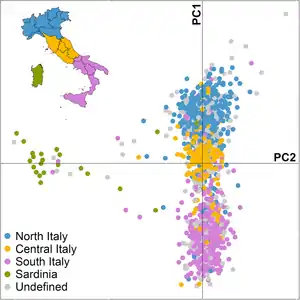
Several studies involving whole genome analysis of Italian populations have found that samples from Northern Italy, Southern Italy and Sicily belong to their own unique separate clusters, while a genetic gap is filled by an intermediate Central Italian cluster, creating a continuous cline of variation that mirrors geography.[75][76] Genetically, Sicilians cluster the closest to Southern Italians, and especially to Calabrians.[77] Other studies have also demonstrated that the population of Sicily is genetically very similar to that of Malta, and to certain Greek population groups from the Ionian Islands, the Aegean Islands, Crete and the Peloponnese, while the rest of mainland Greece appears as slightly differentiated, by clustering with the other Southern Balkan populations of Albania/Kosovo and the Arbereshe people.[78][79][80][81][82][83][84][85][86][77][87][88][89]
MtDna and Y DNA studies
According to one study, Y-DNA haplogroups were found at the following frequencies in Sicily: R1 (36.76%), J (29.65%), E1b1b (18.21%), I (7.62%), G (5.93%), T (5.51%), Q (2.54%).[90] R1 and I haplogroups are typical in West European and North European populations while J, T, G, Q and E1b1b (and their various subclades) consist of lineages with differential distribution across West Asia, North Africa and Europe. The five main MtDNA haplogroups present in Sicily are haplogroups H, K, X, W and U, which are also the five most commonly found MtDNA-haplogroups in Europe, the Caucasus and the Middle East.
The Norman civilisation proliferated for several centuries on the island, with a strong impact on the culture, and English, Franks, Bretons and Lombards and other mainland Italians primarily repopulated the island during this time, along with the ruling Norman elites. The Norman Kingdom of Sicily was created in 1130, with Palermo as its capital, and would last until the 18th century. Nowadays, it is in north-west Sicily, around Trapani, Palermo and Agrigento that Norman Y-DNA is the most common, with 15-20% of the lineages belonging to haplogroup I. Ancient and medieval Greek genetic paternal legacy is estimated at 37% in Sicily, and Arab-Berber (Ifriqiya) at 6-8%, estimates varying only slightly between studies.[91][90] A recent genetic study of uniparental markers in Southern Italian and Sicilian populations has shown that Sicilians are very closely related to mainland Italians from the adjacent regions in southern Italy, as well as to the Maltese people, Peloponnesian Greeks and Greek islanders.[86][92][93][94]
| Frequencies (in %) of haplogroups.[90][93][95][96][97][98][99] | ||
|---|---|---|
| Y-chromosome | mtDNA | |
| 3,5% I1 | 5% HV | |
| 3,5% I2 | 45,2% H | |
| 4,5% R1a | 2,3% HV0+V | |
| 30,5% R1b | 6,7% J | |
| 9% G | 7,1% T | |
| 23% J2 | 10% U* | |
| 3% J* + J1 | 6,3% K | |
| 18% E1b1b | 6% N1+I | |
| 4% T | 1% N2+W | |
| 0% L | 3,7% X | |
| 1% Q | 6,7% Other | |
Culture
Languages


Today in Sicily most people are bilingual and speak both Italian and Sicilian, a distinct and historical Romance language of the Italo-Dalmatian family. Many Sicilian words are of Greek origin, while smaller numbers of other loan words are from Norman, Arabic, Catalan, Occitan, Spanish and other languages. Other dialects of Sicilian, or those very closely related to it, are also spoken in southern Calabria, Salento and Salerno.[100][101]
Sicilian was an early influence in the development of standard Italian, although its use remained confined to an intellectual elite. This was a literary language in Sicily created under the auspices of Frederick II and his court of notaries or Magna Curia which, headed by Giacomo da Lentini, also gave birth to the Sicilian School, widely inspired by troubadour literature. It is in this language that appeared the first sonnet, whose invention is attributed to Giacomo da Lentini himself. Sicilian was also the official language of the Kingdom of Sicily from 1300 to 1543. Prior to the 20th century, large numbers of Sicilian people spoke only Sicilian as their mother tongue, with little or no fluent knowledge of Italian. Today, while Sicilian is an unrecognized language being used as part of many people's daily life, Italian is the only official language and predominates in the public arena.
The Siculo-Arabic dialect was a vernacular variety of Arabic once spoken in Sicily and neighbouring Malta between the end of the ninth century and the end of the twelfth century. The language became extinct in Sicily, but in Malta it eventually evolved into what is now the Maltese language.
The Siculish dialect is the macaronic "Sicilianization" of English language words and phrases by immigrants from Sicily to the United States in the early 20th century. Forms of Siculish are also to be found in other Sicilian immigrant communities of English-speaking countries, namely Canada and Australia. A surprising similarity can often be found between these forms, through either coincidence, trans-national movements of Sicilian immigrants, or more likely, through the logical adaptation of English using linguistic norms from the Sicilian language.
Ethno-linguistic minorities
There are two main historical ethno-linguistic minorities in Sicily, the Lombards of Sicily and the Arbëreshë:
- The Lombards of Sicily are a linguistic minority living in Sicily who speak an isolated variety of Gallo-Italic dialects, the so-called Gallo-Italic of Sicily. The Gallo-Italic of Sicily is a group of Gallo-Italic languages found in about 15 isolated communities of central eastern Sicily. Forming a language island in the Sicilian language,[102][103] it dates back to migrations from Northern Italy during the era of Roger I of Sicily[104] and his successors. The Lombards of Sicily, who originally hailed from Northern Italy, settled the central and eastern part of Sicily about 900 years ago, during the Norman conquest of Sicily. Because of linguistic differences among the Gallo-Italic dialects of Sicily, it is supposed that there were different immigration routes. From Piedmont, Liguria, Emilia, and Lombardy they began to spread south between the 11th and 14th centuries. The most important areas where the Gallo-Italic of Sicily is spoken are Acquedolci, Montalbano Elicona, Novara di Sicilia, Fondachelli-Fantina San Fratello and San Piero Patti (Province of Messina), Aidone, Nicosia, Piazza Armerina and Sperlinga (Province of Enna).
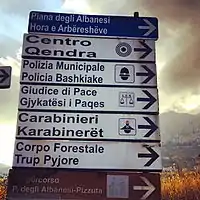
- The Arbëreshë people settled in Southern Italy in the 15th to 18th centuries in several waves of migrations. They are the descendants of mostly Tosk Albanian refugees of Christian faith who fled to Italy after the Albanian conquest and subsequent Islamisation by the Ottoman Turks in the Balkans. They speak their own variant of the Arbëresh language. There are three identified Arbëreshë communities in the province of Palermo, which have maintained unchanged, with different aspects together, the ethnic, linguistic and religious origins. The areas are: Contessa Entellina, Piana degli Albanesi and Santa Cristina Gela; while the varieties of Piana and Santa Cristina Gela are similar enough to be entirely mutually intelligible, the variety of Contessa Entellina is not entirely intelligible. The largest centre is Piana degli Albanesi which, besides being the hub of religious and socio-cultural communities, has guarded and defended their peculiarities intact over time. There are two other communities with a strong historical and linguistic heritage.
- The community of the Greeks of Messina (or Siculo-Greeks) speaks modern Greek with some elements of the ancient Greek language spoken in the island, and Calabrian Greek. The Greek community was reconstituted in 2003 with the name of "Comunità Hellenica dello Stretto" (Hellenic Community of the Strait).
Religion
The vast majority of Sicilians are baptized as Roman Catholic. The Catholic religion represents one of the most important elements of the Sicilian history and identity. The Virgin Hodegetria is the patroness of Sicily. The Sicilian people are also known for their deep devotion to some Sicilian female saints: the martyrs Agatha and Lucy, respectively patroness of Catania and Syracuse, and the hermitess Rosalia, patroness of Palermo. The Sicilian people have significantly contributed to the history of Christianity. There were four Sicilian Popes (Agatho, Leo II, Sergius I, Stephen III) and a Sicilian Ecumenical Patriarch of Constantinople (Methodios I).
Art and architecture
Cuisine
Gallery
- Sicilian folk costumes and traditions
 Sicilian artigiana at a presepe vivente at Santa Maria La Stella, Sicily
Sicilian artigiana at a presepe vivente at Santa Maria La Stella, Sicily Boy in Sicilian costume of the 1880s
Boy in Sicilian costume of the 1880s Girl wearing a costume of the 1880s period in Sicily
Girl wearing a costume of the 1880s period in Sicily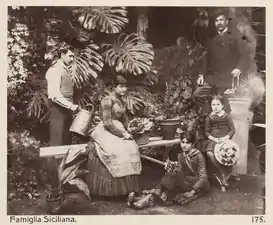 Sicilian family, 1880s.
Sicilian family, 1880s.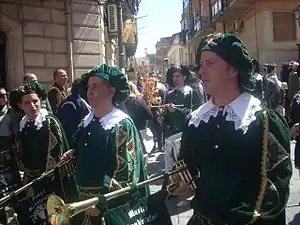 Sicilian band in medieval costumes
Sicilian band in medieval costumes
 A Sicilian artisan in Sutera
A Sicilian artisan in Sutera_-_n._020_(Timbrato_sul_retro).jpg.webp) Two peasants wearing a Sicilian costume, 1880s
Two peasants wearing a Sicilian costume, 1880s_-_n._0024_-_Pescatore_catanese.jpg.webp) Fisherman from Catania, 1890s.
Fisherman from Catania, 1890s._-_n._0036_-_da_-_Sicilia_mitica_Arcadia_-_p._61.jpg.webp) A girl holding an amphora, Limina, 1880/1890
A girl holding an amphora, Limina, 1880/1890 Catacombe dei Cappuccini, Palermo
Catacombe dei Cappuccini, Palermo
See also
References
- "Statistiche demografiche ISTAT". Demo.istat.it.
- "sìculo in Vocabolario - Treccani". www.treccani.it.
- Minahan, James (2000). One Europe, Many Nations: A Historical Dictionary of European National Groups. Greenwood Publishing Group. p. 776. ISBN 978-0-313-30984-7.
Romance (Latin) nations... Sicilians
- Fine, John Van Antwerp (June 30, 1983). The Ancient Greeks: A Critical History. Harvard University Press. ISBN 9780674033146 – via Google Books.
- "Lacus Curtius Dionysius' Roman Antiquities — Book I Chapters 44.3‑71". penelope.uchicago.edu.
- https://halshs.archives-ouvertes.fr/halshs-01670082/document
- The basic study is Joshua Whatmough in R.S. Conway, J. Whatmough and S.E. Johnson, The Prae-Italic Dialects of Italy (London 1933) vol. 2:431-500; a more recent study is A. Zamponi, "Il Siculo" in A.L. Prosdocimi, ed., Popoli e civiltà dell'Italia antica, vol. 6 "Lingue e dialetti" (1978949-1012.)
- Fine, John (1985). The ancient Greeks: a critical history. Harvard University Press. p. 72. ISBN 0674033140.
Most scholars now believe that the Sicans and Sicels, as well as the inhabitants of southern Italy, may of been of Indo-European Illyrian stock superimposed on an aboriginal "Mediterranean" population.
- Servius' commentary on Aeneid VII.795; Dionysius of Halicarnassus i.9.22.
- Diodorus Siculus V.6.3-4.
- Sjöqvist, Erik (1973). Sicily and the Greeks: Studies in the Interrelationship between the Indigenous Populations and the Greek Colonists. Jerome Lectures. Ann Arbor: University of Michigan Press. ISBN 0-472-08795-9.
- Thucydides reported that there were still Siculi in Italia, which only referred approximately to the modern Calabria in his time; he derived Italia from an eponymous Italos, a Sicel king (Histories, vi.4.6), cf. Name of Italy.
- "Elimo". mnamon.sns.it.
- Agostiniani, Luciano (2012). "Alfabetizzazione della Sicilia pregreca". Aristonothos 4. Retrieved January 22, 2018.
- Lemmers, Nadine (September 26, 2017). "Dolmens in Sicily".
- Necropolis of Pantalica
- "Pantalica (Sicily) from the Late Bronze Age to the Middle Ages" (PDF). 2014. Retrieved 2020-06-30.
- "World heritage nomination" (PDF). whc.unesco.org. 2005. Retrieved 2020-06-30.
- Robert Leighton (2011). "Pantalica (Sicily) from the Late Bronze Age to the Middle Ages: A New Survey and Interpretation of the Rock-Cut Monuments" (PDF). American Journal of Archaeology. 115 (3): 447–464. doi:10.3764/aja.115.3.0447. JSTOR 10.3764/aja.115.3.0447.
- "Necropolis of Pantalica, a suggestive and ancient site in eastern Sicily". April 10, 2018.
- McGuire, Gillian. "The Story Behind Sicily's Incredible Rocky Necropolis of Pantalica". Culture Trip.
- "The Thinking Traveller | Exclusive luxury villa holidays". www.thethinkingtraveller.com.
- Santoni, Vincenzo; Sabatini, Donatella (2010). "Relazione e analisi preliminare". Campagna di scavo (PDF) (Report). Gonnesa, Nuraghe Serucci. IX.
- Pantalica e i suoi monumenti di Paolo Orsi
- Voza, Giuseppe. "Thapsos". Retrieved 27 November 2014.
- https://www.academia.edu/27899399/Origins_of_the_Iberomaurusian_in_NW_Africa_New_AMS_radiocarbon_dating_of_the_Middle_and_Later_Stone_Age_deposits_at_Taforalt_Cave_Morocco, pp. 268
- 2005 D. Lubell. Continuité et changement dans l'Epipaléolithique du Maghreb. In, M. Sahnouni (ed.) Le Paléolithique en Afrique: l’histoire la plus longue, pp. 205-226. Paris: Guides de la Préhistoire Mondiale, Éditions Artcom’/Errance.
- 2004 N. Rahmani. Technological and cultural change among the last Hunter-Gatherers of the Maghreb: the Capsian (10,000 B.P. to 6000 B.P.). Journal of World Prehistory 18(1): 57-105.
- Spoto, Salvatore. Sicilia Antica: Castelluccio e l'Età del bronzo, p.51.
- Spoto, Salvatore. Op. cit., p.323.
- Jean, Huré. Storia della Sicilia dalle Origini ai giorni nostri, p.12.
- Piccolo, Salvatore. Op. cit., p.31 et seq.
- Macrobius, Saturnalia 5.19.15
- Witczak, K. T.; Zawiasa, D. "The Sicilian Palici as representatives of the indo-european divine twins". In: ΜΥΘΟΣ, n. 12, 2004-2005. pp. 93-106.
- Schmitz, Leonhard (1870), "Aetna", in Smith, William (ed.), Dictionary of Greek and Roman Biography and Mythology, 1, Boston, p. 54
- Diodorus Siculus, Bibliotheca historica 4.7.6 & 4.8.3
- Callimachus, Hymn III to Artemis 8-10.
- Ovid, Fasti4.287–288, 4.473.
- Hard, pp 66, p. 166; Fowler 2013, p. 54; Bremmer, p. 139; Grimal, p. 119 s.v. Cyclopes.
- "This April, I spent a month in Western Sicily, where I discovered much evidence of worship of the Goddesses Tanit, Astarte and Venus/Aphrodite, as well as Demeter and Persephone. I visited an abundance of ancient sacred sites dedicated to the aforementioned goddesses during my stay in Sicily" https://experiencesicily.com/2018/12/04/sicily-and-the-myth-of-demeter-and-kore/
- "This April, I spent a month in Western Sicily, where I discovered much evidence of worship of the Goddesses Tanit, Astarte and Venus/Aphrodite, as well as Demeter and Persephone. I visited an abundance of ancient sacred sites dedicated to the aforementioned goddesses during my stay in Sicily (para quote)" https://goddess-pages.co.uk/galive/issue-12-home/goddesses-of-love-sex-death-in-sicily/
- Edward Augustus Freeman (1894). The History of Sicily from the Earliest Times:Volume IV. Oxford University Press. Retrieved 5 December 2011.
- "Homesick Phoenicians imported plants, animals to new Sicilian island home 3,000 years ago". Haaretz.com.
- "The Temple of Astarte at Erice | Goddess Alive!". goddess-pages.co.uk.
- "Unique Phoenician temple found in Sicily". ITALY Magazine.
- "Sicilian Peoples: The Elymians - Best of Sicily Magazine - Elami, Elymi, Elimi, Elimi in Sicilia, Segesta, Eryx, Entella". www.bestofsicily.com.
- Thucydides, His. VI,2,3,4.
- "Sicily: Encyclopedia II – Sicily – History". Experience Festival. 7 October 2007. Archived from the original on 31 December 2013.
- "Aapologetico de la literatura española contra los opiniones". Ensayo historico. 7 October 2007.
- Shefton, Brian Benjamin; Lomas, Kathryn (2004). "Greek Identity in the Western Mediterranean". ISBN 9004133003.
- Fine, John (1985). The ancient Greeks: a critical history. Harvard University Press. p. 72. ISBN 0-674-03314-0.
- The World's Writing Systems. 1996:301.
- 'Sicanian' at Linguist List
- Vincent, Martzloff (2011). "Variation linguistique et exégèse paléo-italique. L'idiome sicule de Montagna di Marzo". La variation linguistique dans les langues de l’Italie préromaine (in French). Lyon. Archived from the original on 2015-04-02.
- Fortson, Benjamin W. IV (2009). Indo-European Language and Culture (Second ed.). Malden/Oxford: Wiley-Blackwell. p. 469. ISBN 978-1-4051-8895-1.
- Cordano, Federica (2012). "Iscrizioni monumentali dei Siculi". Aristonothos 4. Retrieved January 22, 2018.
- Bonfante, Larissa (1986). Etruscan Life and Afterlife: A Handbook of Etruscan Studies. Wayne State University Press. pp. 75–. ISBN 0-8143-1813-4.
- Brice, Lee L. (21 April 2014). Warfare in the Roman Republic: From the Etruscan Wars to the Battle of Actium: From the Etruscan Wars to the Battle of Actium. ABC-CLIO. pp. 277–. ISBN 978-1-61069-299-1.
- Raymond Davis (translator), The Book of Pontiffs (Liber Pontificalis), first edition (Liverpool: University of Liverpool Press, 1989), p. 87
- Described in great detail by Andreas Agnellus (chaps. 138-140), whose ancestor Johannicus was one of those carried off; Deborah Mauskopf Deliyannis (translator and editor), The Book of Pontiffs of the Church of Ravenna (Washington: Catholic University of America Press, 2004), pp.259-265.
- "Jawhar as-Siqilli". www.ismaili.net.
- Monés, Hussain (April 24, 2012). "D̲j̲awhar al-Ṣiḳillī". Encyclopaedia of Islam, Second Edition – via referenceworks.brillonline.com.
- James Minahan, Encyclopedia of the Stateless Nations: Ethnic and National Groups Around the World A-Z, 2002 p.1714.
- Wærn, Cecilia (1910). Mediaeval Sicily, aspects of life and art in the middle ages. London, Duckworth & Co.
- Aggarwal, Narendra (October 8, 2018). "Italians among fastest-growing EU nationals in Singapore". The Business Times.
- "..:Benvenuto sul sito dell'U.S.E.F.:." www.usefinternational.org.
- "Statistiche demografiche ISTAT". Demo.istat.it. Retrieved 29 May 2016.
- "Legge 482". camera.it.
- "Corriere della Sera – Italia, quasi l'88% si proclama cattolico". corriere.it.
- Boix, Rafael; Veneri, Paolo (30 September 2010). Metropolitan Areas in Spain and Italy (Report). hdl:2072/87965.
- "Statistiche demografiche ISTAT". demo.istat.it.
- "Istat, Demographics, updated to May 2011". Demo.istat.it. Retrieved 28 October 2011.
- I venti cognomi più diffusi in Sicilia - siciliafan.it
- Parolo, Silvia; Lisa, Antonella; Gentilini, Davide; Di Blasio, Anna Maria; Barlera, Simona; Nicolis, Enrico B.; Boncoraglio, Giorgio B.; Parati, Eugenio A.; Bione, Silvia (2015). "Characterization of the biological processes shaping the genetic structure of the Italian population". BMC Genetics. 16: 132. doi:10.1186/s12863-015-0293-x. PMC 4640365. PMID 26553317.
- Sazzini, M.; Ruscone, G (2016). "Complex interplay between neutral and adaptive evolution shaped differential genomic background and disease susceptibility along the Italian peninsula". Nature. 6: 32513. Bibcode:2016NatSR...632513S. doi:10.1038/srep32513. PMC 5007512. PMID 27582244. Zendo: 165505.
- Di Gaetano, C; Voglino, F; Guarrera, S; Fiorito, G; Rosa, F; Di Blasio, AM; Manzini, P; Dianzani, I; Betti, M; Cusi, D; Frau, F; Barlassina, C; Mirabelli, D; Magnani, C; Glorioso, N; Bonassi, S; Piazza, A; Matullo, G (2012). "An Overview of the Genetic Structure within the Italian Population from Genome-Wide Data". PLOS ONE. 7 (9): e43759. Bibcode:2012PLoSO...743759D. doi:10.1371/journal.pone.0043759. PMC 3440425. PMID 22984441.
- Raveane, A.; Aneli, S.; Montinaro, F.; Athanasiadis, G.; Barlera, S.; Birolo, G.; Boncoraglio, G. (4 September 2019). "Population structure of modern-day Italians reveals patterns of ancient and archaic ancestries in Southern Europe". Science Advances. 5 (9): eaaw3492. Bibcode:2019SciA....5.3492R. doi:10.1126/sciadv.aaw3492. PMC 6726452. PMID 31517044.
- Sarno, Stefania (16 May 2017). "Ancient and recent admixture layers in Sicily and Southern Italy trace multiple migration routes along the Mediterranean". Scientific Reports. 7 (1): 1984. doi:10.1038/s41598-017-01802-4. PMC 5434004. PMID 28512355. S2CID 669567.
- Anthropological Review | Volume 81: Issue 3 A glance of genetic relations in the Balkan populations utilizing network analysis based on in silico assigned Y-DNA haplogroups; Scientific study detailing the close genetic relationship of mainland Greeks with other Balkan population groups https://content.sciendo.com/view/journals/anre/81/3/article-p252.xml?language=en
- "By principal component analysis (PCA) and ADMIXTURE analysis the 'Peloponnesians' are clearly distinguishable from the populations of the Slavic & Balkan homeland, and are very similar to 'Sicilians' and Southern Italians." https://www.researchgate.net/publication/314401076_Genetics_of_the_peloponnesean_populations_and_the_theory_of_extinction_of_the_medieval_peloponnesean_Greeks
- Paschou, Peristera; Drineas, Petros; Yannaki, Evangelia; Razou, Anna; Kanaki, Katerina; Tsetsos, Fotis; Padmanabhuni, Shanmukha Sampath; Michalodimitrakis, Manolis; Renda, Maria C.; Pavlovic, Sonja; Anagnostopoulos, Achilles; Stamatoyannopoulos, John A.; Kidd, Kenneth K.; Stamatoyannopoulos, George (24 June 2014). "Maritime route of colonization of Europe". Proceedings of the National Academy of Sciences of the United States of America. 111 (25): 9211–9216. Bibcode:2014PNAS..111.9211P. doi:10.1073/pnas.1320811111. PMC 4078858. PMID 24927591.
- Drineas, Petros; Tsetsos, Fotis; Plantinga, Anna; Lazaridis, Iosif; Yannaki, Evangelia; Razou, Anna; Kanaki, Katerina; Michalodimitrakis, Manolis; Perez‐Jimenez, Francisco; De Silvestro, Giustina; Renda, Maria C.; Stamatoyannopoulos, John A.; Kidd, Kenneth K; Browning, Brian L.; Paschou, Peristera; Stamatoyannopoulos, George (November 2019). "Genetic history of the population of Crete". Annals of Human Genetics. 83 (6): 373–388. doi:10.1111/ahg.12328. PMC 6851683. PMID 31192450.
- Stamatoyannopoulos, George; Bose, Aritra; Teodosiadis, Athanasios; Tsetsos, Fotis; Plantinga, Anna; Psatha, Nikoletta; Zogas, Nikos; Yannaki, Evangelia; Zalloua, Pierre; Kidd, Kenneth K; Browning, Brian L; Stamatoyannopoulos, John; Paschou, Peristera; Drineas, Petros (May 2017). "Genetics of the peloponnesean populations and the theory of extinction of the medieval peloponnesean Greeks". European Journal of Human Genetics. 25 (5): 637–645. doi:10.1038/ejhg.2017.18. PMC 5437898. PMID 28272534.
- Arauna, Lara R.; Hellenthal, Garrett; Comas, David (May 2019). "Dissecting human North African gene-flow into its western coastal surroundings". Proceedings of the Royal Society B: Biological Sciences. 286 (1902): 20190471. doi:10.1098/rspb.2019.0471. PMC 6532504. PMID 31039721.
- Falchi, Alessandra; Vacca, Lucia; Lopez Alomar, Antonio; Esteban, Esther; Memmi, Marc; Varesi, Laurent; Moral, Pedro; Vona, Giuseppe (2004). "Population variability in some genes involving the haemostatic system: data on the general population of Corsica (France), Sardinia and Sicily (Italy)". Genetics and Molecular Biology. 27 (2): 139–146. doi:10.1590/S1415-47572004000200002.
- Hajjej, Abdelhafidh; Almawi, Wassim Y.; Arnaiz-Villena, Antonio; Hattab, Lasmar; Hmida, Slama (9 March 2018). "The genetic heterogeneity of Arab populations as inferred from HLA genes". PLOS ONE. 13 (3): e0192269. Bibcode:2018PLoSO..1392269H. doi:10.1371/journal.pone.0192269. PMC 5844529. PMID 29522542.
- Pakstis, Andrew J.; Gurkan, Cemal; Dogan, Mustafa; Balkaya, Hasan Emin; Dogan, Serkan; Neophytou, Pavlos I.; Cherni, Lotfi; Boussetta, Sami; Khodjet-El-Khil, Houssein; Ben Ammar ElGaaied, Amel; Salvo, Nina Mjølsnes; Janssen, Kirstin; Olsen, Gunn-Hege; Hadi, Sibte; Almohammed, Eida Khalaf; Pereira, Vania; Truelsen, Ditte Mikkelsen; Bulbul, Ozlem; Soundararajan, Usha; Rajeevan, Haseena; Kidd, Judith R.; Kidd, Kenneth K. (December 2019). "Genetic relationships of European, Mediterranean, and SW Asian populations using a panel of 55 AISNPs". European Journal of Human Genetics. 27 (12): 1885–1893. doi:10.1038/s41431-019-0466-6. PMC 6871633. PMID 31285530.
- Fiorito, Giovanni; Di Gaetano, Cornelia; Guarrera, Simonetta; Rosa, Fabio; Feldman, Marcus W.; Piazza, Alberto; Matullo, Giuseppe (July 2016). "The Italian genome reflects the history of Europe and the Mediterranean basin". European Journal of Human Genetics. 24 (7): 1056–1062. doi:10.1038/ejhg.2015.233. PMC 5070887. PMID 26554880.
- King, Roy J.; et al. (2008). "Differential Y-chromosome Anatolian influences on the Greek and Cretan Neolithic". Annals of Human Genetics. 72 (Pt 2): 205–214. https://www.semanticscholar.org/paper/Differential-Y-chromosome-Anatolian-influences-on-King-Ozcan/3f624326399b8c36dd94e29af7f1096408778f5d
- Di Gaetano, Cornelia; Cerutti, Nicoletta; Crobu, Francesca; Robino, Carlo; Inturri, Serena; Gino, Sarah; Guarrera, Simonetta; Underhill, Peter A; King, Roy J; Romano, Valentino; Cali, Francesco; Gasparini, Mauro; Matullo, Giuseppe; Salerno, Alfredo; Torre, Carlo; Piazza, Alberto (January 2009). "Differential Greek and northern African migrations to Sicily are supported by genetic evidence from the Y chromosome". European Journal of Human Genetics. 17 (1): 91–99. doi:10.1038/ejhg.2008.120. PMC 2985948. PMID 18685561.
- Capelli, C; Onofri, V; Brisighelli, F; et al. (2009). "Moors and Saracens in Europe, estimating the medieval North African male legacy in southern Europe". European Journal of Human Genetics. 17 (6): 848–52. doi:10.1038/ejhg.2008.258. PMC 2947089. PMID 19156170.
- Cappadonia, Chiara; Coratza, Paola; Agnesi, Valerio; Soldati, Mauro (2018). "Malta and Sicily Joined by Geoheritage Enhancement and Geotourism within the Framework of Land Management and Development". Geosciences. 8 (7): 253. Bibcode:2018Geosc...8..253C. doi:10.3390/geosciences8070253.
- Sarno, Stefania; Boattini, Alessio; Carta, Marilisa; Ferri, Gianmarco; Alù, Milena; Yao, Daniele Yang; Ciani, Graziella; Pettener, Davide; Luiselli, Donata (30 April 2014). "An Ancient Mediterranean Melting Pot: Investigating the Uniparental Genetic Structure and Population History of Sicily and Southern Italy". PLOS ONE. 9 (4): e96074. Bibcode:2014PLoSO...996074S. doi:10.1371/journal.pone.0096074. PMC 4005757. PMID 24788788.
- Caruana, Josef (2013). Population genetics of Western Mediterranean islands: Malta, a case study (Thesis). University of Manchester.
- Francalacci, P (13 March 2003). "Peopling of three Mediterranean islands (Corsica, Sardinia, and Sicily) inferred by Y-chromosome biallelic variability". American Journal of Physical Anthropology. 121 (3): 270–279. doi:10.1002/ajpa.10265. PMID 12772214.
- Capelli, C (13 September 2005). "Population Structure in the Mediterranean Basin: A Y Chromosome Perspective". Annals of Human Genetics. 70 (2): 207–225. doi:10.1111/j.1529-8817.2005.00224.x. hdl:2108/37090. PMID 16626331. S2CID 25536759.
- Capelli, C (21 January 2009). "Moors and Saracens in Europe: estimating the medieval North African male legacy in southern Europe". European Journal of Human Genetics. 17 (6): 848–852. doi:10.1038/ejhg.2008.258. PMC 2947089. PMID 19156170.
- Brisighelli, Francesca (2012). "Uniparental Markers of Contemporary Italian Population Reveals Details on Its Pre-Roman Heritage". PLOS ONE. 7 (12): e50794. Bibcode:2012PLoSO...750794B. doi:10.1371/journal.pone.0050794. PMC 3519480. PMID 23251386.
- Tofanelli, Sergio; Brisighelli, Francesca; Anagnostou, Paolo; Busby, George B J; Ferri, Gianmarco; Thomas, Mark G; Taglioli, Luca; Rudan, Igor; Zemunik, Tatijana; Hayward, Caroline; Bolnick, Deborah; Romano, Valentino; Cali, Francesco; Luiselli, Donata; Shepherd, Gillian B; Tusa, Sebastiano; Facella, Antonino; Capelli, Cristian (March 2016). "The Greeks in the West: genetic signatures of the Hellenic colonisation in southern Italy and Sicily". European Journal of Human Genetics. 24 (3): 429–436. doi:10.1038/ejhg.2015.124. PMC 4757772. PMID 26173964.
- Devoto, Giacomo; Giacomelli, Gabriella (1972). I dialetti delle regioni d'Italia [Dialects of the regions of Italy] (in Italian). Florence: Sansoni. p. 143.
- Avolio, Francesco (2012). Lingue e dialetti d'Italia [Languages and dialects of Italy] (in Italian) (2nd ed.). Rome: Carocci. p. 54.
- Salvatore Carmelo Trovato, La Sicilia, in Cortelazzo et al. I dialetti italiani, UTET, Torino 2002, p. 882. (In Italian)
- Toso, Fiorenzo (2010). "Gallo-italica, comunità". Enciclopedia dell'Italiano, Treccani, 2010 (in Italian). Treccani.
- Isaacs, Ann Katherine (July 7, 2007). Immigration and Emigration in Historical Perspective. p. 71. ISBN 978-88-8492-498-8.
External links
| Wikimedia Commons has media related to People of Sicily. |
